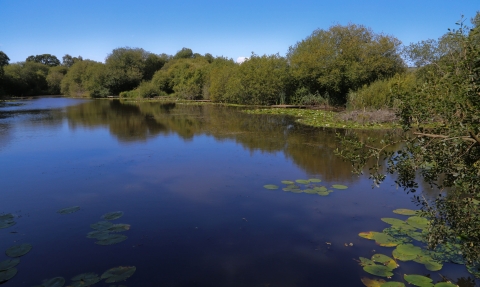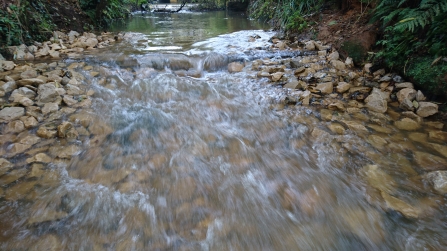
Eastern Yar, Isle of Wight © Ian Pratt
Wetland Restoration

The Eastern Yar is the longest river on the Isle of Wight, rising from chalk downs near Niton and joining the sea at Bembridge Harbour. Much of its course is naturally characterised by floodplains and wetlands, providing a haven for kingfishers, water voles, Cetti's warblers, and water-loving plants like marsh cinquefoil.
Sadly, over the years the river has been increasingly altered by the addition of concrete weirs, steep-sided channels, and other kinds of infrastructure. These alterations prevent the river from following its natural course and cut it off from its floodplain, resulting in a loss of precious habitat for wildlife.
From 2016-2020 we undertook large-scale restoration works to help return the Eastern Yar to its former glory. These ranged from clearing scrub and restoring reed beds to re-meandering watercourses and adding fish passes to bridges and weirs. Working with partners and landowners, the project established an interconnected and diverse series of wetland habitats across the river valley and beyond.
The Wetland Restoration project was part of Down to the Coast, a wider project which conserved nature and heritage across the eastern Isle of Wight. It was made possible by the National Lottery Heritage Fund, who we would like to thank for their support. Enormous thanks also to the amazing volunteers who gave 3,350 hours of their time – we couldn’t have done it without you.

River restoration work on the Eastern Yar
Enhancing our land
One of the project's primary aims was to establish an eight-kilometre nature corridor between Bembridge and Alverstone - an unbroken stretch of land being managed for wildlife. Our own Sandown Meadows Nature Reserve sits within it, and received improvements such as adding scrapes, removing willow scrub, and introducing fencing so the site could be grazed.
Even more exciting, though, was the chance to complete the corridor by purchasing 10 hectares of land next to Sandown Meadows. After extensive restoration - including adding drains, ponds, and fencing - this once degraded pasture became Morton Marsh Nature Reserve. This wonderful wetland has been further upgraded with the addition of scrapes, a sand martin nesting bank, interpretation boards, and a viewing platform.
Land at the Isle of Wight Donkey Sanctuary, restored as part of Down to the Coast © Lianne de Mello
Working in partnership
In addition to improving our own land, we undertook restoration works at key sites owned privately or by other conservation organisations. Alverstone Marshes Site of Special Scientific Interest contains rare fen habitat, and is nationally important for its biodiversity - removing scrub from the site allowed it to better function as a floodplain. Another site that received scrub clearance was Bohemia Bog, which is one of the most diverse botanical sites on the island.
We also teamed up with the Isle of Wight Donkey Sanctuary to deliver a range of improvements on their land. Wroxall Stream, which runs through the site, was overgrown with blackthorn and bramble scrub - clearing this allowed more light to reach the watercourse. We also installed fencing to facilitate conservation grazing and enhanced the site with wildlife-focused walking routes and interpretation.
